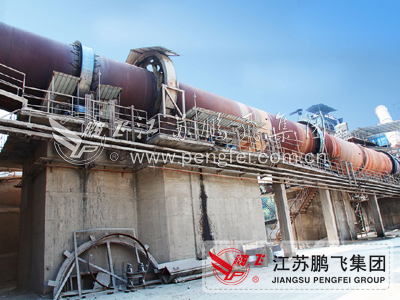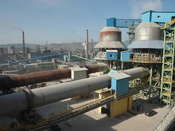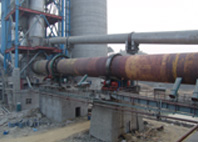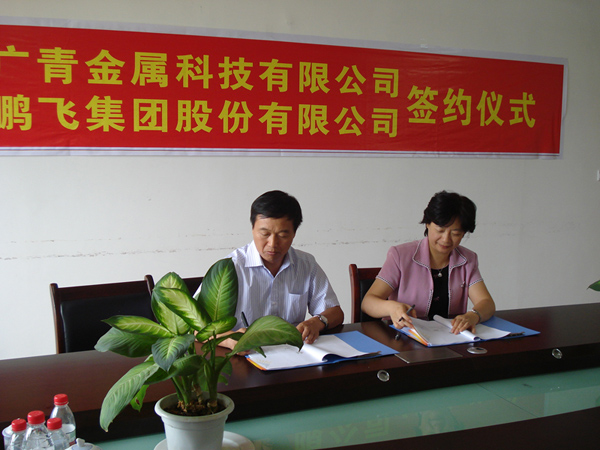Wet rotary kilns belong to the category of building materials equipment and are widely used in industries such as metallurgy, chemical engineering, building refractory materials, and environmental protection. The rotary kiln consists of a cylinder body, a support device, a supporting device with a stop wheel, a transmission device, a movable kiln head, a kiln tail sealing device, a coal injection pipe device, and other components. The kiln body of the wet rotary kiln is inclined to a certain degree from the horizontal, and the entire kiln body is supported by a supporting wheel device, with a stop wheel device that controls the upward and downward movement of the kiln body. In addition to the main transmission, the transmission system also includes an auxiliary transmission device that can still rotate the kiln body when the main power supply is cut off, preventing the kiln body from bending and deforming. The sealing devices at the kiln head and tail adopt advanced technology to ensure the reliability of the seal.
Performance characteristics
Due to the production of slurry from raw materials, it has strong adaptability to heterogeneous raw materials, uniform composition of raw materials, stable process, high quality of sintered clinker, high strength grade of clinker, less dust during grinding process, and less fly ash at the kiln tail. However, during wet production, evaporating 30% to 40% of the slurry moisture requires significant heat consumption, which accounts for 1/2 to 1/3 of the cement cost. This is higher than both vertical and dry rotary kilns. Due to high heat consumption, high energy consumption, and large water consumption during production, wet cement production has been classified as a restricted and phased out kiln type in China.
Basic functions
In order to calcine good cement clinker and reduce coal consumption, wet rotary kilns should have the following basic functions:
1. It is possible to inject coal powder into the kiln in a dispersed state and at a certain speed, in order to enhance the mixing of coal and air.
2. It can enhance gas disturbance, increase gas diffusion speed, and blow away the volatile gas film around coal powder particles, expanding the contact between fixed carbon and secondary air.
3. Can supplement an appropriate amount of fresh air to solve the problem of oxygen deficiency in the flame center area.
4. Low primary air consumption improves the utilization rate of clinker recovery heat.
5. Can quickly adapt to changes in incoming materials, the shape and length of the flame, and the position of the flame should be easily controllable and adjustable.
6. Has strong adaptability to combustion quality.
7. The environmental temperature of the wet rotary kiln is very high, and the rotary kiln nozzle should have high temperature resistance characteristics. Effective high temperature resistance measures should be taken to prevent the nozzle from being burned out.
8. The coal conveying pipeline and nozzle spraying part of the wet rotary kiln should be.
Equipment composition
1. Cylinder and kiln lining: The cylinder is made of rolled steel plates and is a container for materials to undergo physical and chemical changes, thus serving as the body of the rotary kiln. The temperature of the materials inside the kiln can reach above 1450 ℃, so refractory materials are built inside the cylinder to protect it and reduce heat dissipation. According to the process of material changes, the cylinder is divided into various working zones, such as drying zone, preheating zone, decomposition zone, firing zone, and cooling zone.
2. Heat exchanger: To enhance the heat exchange effect, various types of chains are often hung inside the cylinder to form a heat exchange device.
3. Wheel belt: The weight of all rotary kiln parts such as the cylinder, kiln lining, and materials is transmitted to the support device through the wheel belt.
4. Support device: It consists of a pair of supporting wheel bearings and a large base. The pair of supporting wheels support a wheel belt, allowing the cylinder to move freely while transmitting a huge load to the foundation. The support device is generally 2-7 gears, and a gear wheel is installed on one or several gears of the support device, which is called a gear wheel support device. Its function is to limit or control the axial movement of the rotary part of the kiln.
5. Transmission device: A gear ring is installed in the middle of the cylinder, and a spring plate is installed on the cylinder. Through gear transmission, the cylinder rotates. At the same time, in order to meet the needs of operation and maintenance, an auxiliary transmission is installed in large rotary kilns to make the kiln rotate at an extremely low speed.
6. Kiln head cover: It is an intermediate connecting the kiln head end and the equipment in the lower process of the process. It is the place where the pyrotechnic operator carries out production operations. Therefore, the shaking head cover is equipped with viewing holes and maintenance doors.
7. Burner: Rotary burners are mostly inserted from the kiln head end of the cylinder, radiating materials and heating them to the required temperature through flames. The burner has coal injection pipes, oil spray guns, gas nozzles, etc.
8. Cold smoke chamber: It is an intermediate connecting the kiln tail, material feeding device, and flue gas treatment equipment. The flue gas is discharged into the flue and dust collection system through the cold smoke chamber. The material is directly fed into the tail of the kiln by the feeding device.
9. Feeding device: It is an auxiliary equipment of the rotary kiln. The requirements for feeding are stable, uniform, and easy to control in order to coordinate with kiln operations.
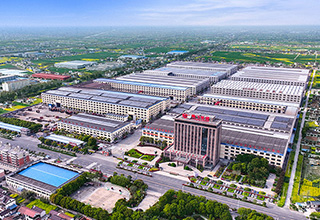
 Real time updates on cutting-edge information, presenting Pengfei and industry trends in a timely, comprehensive, and intuitive manner.
Real time updates on cutting-edge information, presenting Pengfei and industry trends in a timely, comprehensive, and intuitive manner.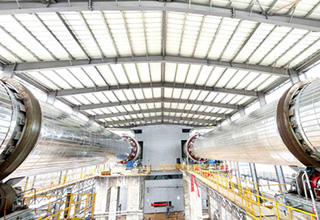
 We firmly believe that talent is the foundation of enterprise development. We adhere to the talent concept of "people-oriented, co creation and win-win", respect the personality and creativity of each employee, and are committed to providing employees with broad development space and a fair competitive platform.
We firmly believe that talent is the foundation of enterprise development. We adhere to the talent concept of "people-oriented, co creation and win-win", respect the personality and creativity of each employee, and are committed to providing employees with broad development space and a fair competitive platform.
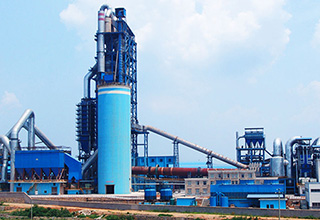

 中文
中文 English
English
